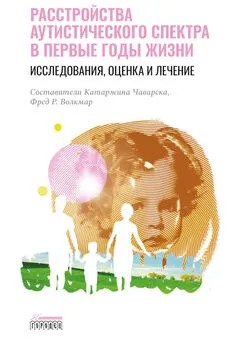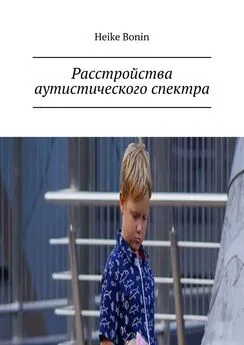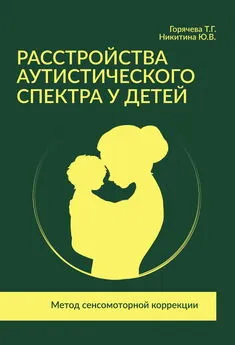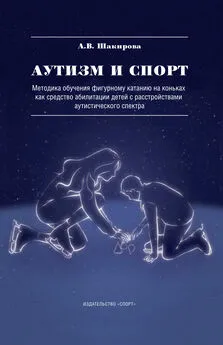Катаржина Чаварска - Расстройства аутистического спектра в первые годы жизни. Исследования, оценка и лечение
- Название:Расстройства аутистического спектра в первые годы жизни. Исследования, оценка и лечение
- Автор:
- Жанр:
- Издательство:неизвестно
- Год:2022
- Город:Москва
- ISBN:978-5-907483-67-5
- Рейтинг:
- Избранное:Добавить в избранное
-
Отзывы:
-
Ваша оценка:
Катаржина Чаварска - Расстройства аутистического спектра в первые годы жизни. Исследования, оценка и лечение краткое содержание
В формате PDF A4 сохранен издательский макет книги.
Расстройства аутистического спектра в первые годы жизни. Исследования, оценка и лечение - читать онлайн бесплатно ознакомительный отрывок
Интервал:
Закладка:
Переход в DSM-5 к расстройствам аутистического спектра отражает интерес и растущий объем исследований в области аутистического спектра. Это имело свои истоки в признании атипичных или «не определенных иным образом» форм расстройства. Со временем растущий объем исследований говорит о том, что аутизм действительно незаметно переходит в норму. Эти данные во многом согласуются со сложностью генетической природы этого состояния.
Как мы уже отмечали в этой главе, для младенцев и детей раннего возраста растущая осведомленность об этом расстройстве и предоставление новых методов лечения, основанных на фактических данных, представляют собой важные возможности для оптимизации обучения и улучшения прогноза. В то же время серьезными препятствиями выступают отсутствие биомаркеров заболевания и сравнительно высокая вариативность в эффективности инструментов скрининга. Как отмечается в других главах настоящего сборника, в настоящее время существует целый ряд новых методологических подходов, направленных на изучение аутизма в его раннем проявлении. Эти исследования перейдут к еще более ранним стадиям развития, например, к поиску отличий во внутриутробном состоянии. Хотя предстоит еще проделать большую работу, очевидно, что было достигнуто немало успехов.
Список литературы
American Psychiatric Association. (1980). Diagnostic and statistical manual of mental disorders (3 rd ed.). Washington, DC: Author.
American Psychiatric Association. (1987). Diagnostic and statistical manual of mental disorders (3 rd ed., rev.). Washington, DC: Author.
American Psychiatric Association. (1994). Diagnostic and statistical manual of mental disorders (4 th ed.). Washington, DC: Author.
American Psychiatric Association. (2000). Diagnostic and statistical manual of mental disorders (4 th ed., text rev.). Washington, DC: Author.
American Psychiatric Association. (2013). Diagnostic and statistical manual of mental disorders (5 th ed.). Arlington, VA: Author.
Anderson, G. M. (2014). Biochemical biomarkers for autism spectrum disorder. In F. R. Volkmar, R. Paul, S. J. Rogers, & K. A. Pelphrey (Eds.), Handbook of autism and pervasive developmental disorders (4 th ed., pp. 457–481). Hoboken, NJ: Wiley.
Asperger, H. (1944). Die «autistichen Psychopathen» im Kindersalter.
Archive fur Psychiatrie und Nervenkrankheiten, 117, 76–136.
Barton, M. L., Dumont-Mathieu, T., & Fein, D. (2012). Screening young children for autism spectrum disorders in primary practice. Journal of Autism and Developmental Disorders, 42 (6), 1165–1174.
Bennett, T., Szatmari, P., Bryson, S., Volden, J., Zwaigenbaum, L., Vaccarella, L., Boyle M. (2008). Diferentiating autism and Asperger syndrome on the basis of language delay or impairment. Journal of Autism and Developmental Disorders, 38 (4), 616–625.
Bettelheim, B. (1974). A home for the heart. New York: Knopf.
Campbell, J. M. (2005). Diagnostic assessment of Asperger’s disorder: A review of fve third-party rating scales. Journal of Autism and Developmental Disorders, 35 (1), 25–35.
Candland, D. K. (1993). Feral children and clever animals: Refections on human nature. New York: Oxford University Press.
Chawarska, K., Chang, J., & Campbell, D. (2015). Clinical correlates of early generalized overgrowth in autism spectrum disorder: In reply. Journal of the American Academy of Child and Adolescent Psychiatry, 54 (11), 958–959.
Chawarska, K., Klin, A., & Volkmar, F. (Eds.). (2008). Autism spectrum disorders in infants and toddlers: Diagnosis, assessment, and treatment. New York: Guilford Press.
Chawarska, K., Macari, S., & Shic, F. (2013). Decreased spontaneous attention to social scenes in 6-month-old infants later diagnosed with autism spectrum disorders. Biological Psychiatry, 74 (3), 195–203.
Chawarska, K., Macari, S., Volkmar, F. R., Kim, S., & Shic, F. (2014). ASD in infants and toddlers. In F. R. Volkmar, R. Paul, S. J. Rogers, & K. A. Pelphrey (Eds.), Handbook of autism and pervasive developmental disorders (4 th ed., Vol. 1., pp. 121–147). Hoboken, NJ: Wiley.
Chawarska, K., Ye, S., Shic, F., & Chen, L. (2016). Multilevel diferences in spontaneous social attention in toddlers with autism spectrum disorder. Child Development, 87 (2), 543–557.
Chiang, H.-M., Cheung, Y. K., Brown, A., & Li, H. (2014). A meta-analysis of diferences in IQ profles between individuals with Asperger’s disorder and high-functioning autism. Journal of Autism and Developmental Disorders, 44 (7), 1577–1596.
Cicchetti, D. V. (1994). Guidelines, criteria, and rules of thumb for evaluating normed and standardized assessment instruments in psychology. Psychological Assessment, 6 (4), 284–290.
Constantino, J. N., & Todd, R. D. (2000). Genetic structure of reciprocal social behavior. American Journal of Psychiatry, 157 (12), 2043–2045.
de Sanctis, S. (1906). On some variations of dementia praecox. Revista Sperimentali di Frenciatria, 32, 141–165.
Doehring, P., & Becker-Conttrill, B. (2013). Autism services across America. Baltimore, MD: Brookes.
Dworzynski, K., Ronald, A., Bolton, P., & Happo, F. (2012). How diferent are girls and boys above and below the diagnostic threshold for autism spectrum disorders? Journal of the American Academy of Child and Adolescent Psychiatry, 51 (8), 788–797.
Elsabbagh, M., Divan, G., Koh, Y.-J., Kim, Y. S., Kauchali, S., Marcon, C., Fombonne, E. (2012). Global prevalence of autism and other pervasive developmental disorders. Autism Research, 5 (3), 160–179.
Factor, D. C., Freeman, N. L., & Kardash, A. (1989). A comparison of DSM – III and DSM – III-R criteria for autism. Journal of Autism and Developmental Disorders, 19 (4), 637–640.
Ferster, C. B. (1972). Clinical reinforcement. Seminars in Psychiatry, 4 (2), 101–111.
Folstein, S., & Rutter, M. (1978). Genetic influences and infantile autism. Annual progress in child psychiatry and child development (pp. 437–441). New York: Brunner/Mazel.
Fraser, R., Cotton, S., Gentle, E., Angus, B., Allott, K., & Thompson, A. (2012). Non-expert clinicians’ detection of autistic traits among attenders of a youth mental health service. Early Intervention in Psychiatry, 6 (1), 83–86.
Freeth, M., Milne, E., Sheppard, E., & Ramachandran, R. (2014). Autism across cultures: Perspectives from non-western cultures and implications for research. In F. R. Volkmar, R. Paul, S. J. Rogers, & K. A. Pelphrey (Eds.), Handbook of autism and pervasive developmental disorders, Vol. 2 (4 th ed., pp. 997–1013). Hoboken, NJ: Wiley.
Gardner, L. M., Campbell, J. M., Keisling, B., & Murphy, L. (2018). Correlates of DSM-5 autism spectrum disorder levels of support ratings in a clinical sample. Journal of Autism and Developmental Disorders, 48 (10), 3513–3523.
Gibbs, V., Aldridge, F., Chandler, F., Witzlsperger, E., & Smith, K. (2012). An exploratory study comparing diagnostic outcomes for autism spectrum disorders under DSM – IV-TR with the proposed DSM-5 revision. Journal of Autism and Developmental Disorders, 42 (8), 1750–1756.
Gillberg, C. (1994). Debate and argument: Having Rett syndrome in the ICD-10 PDD category does not make sense [Comment]. Journal of Child Psychology and Psychiatry and Allied Disciplines, 35 (2), 377–378.
Goldstein, S., Naglieri, J. A., & Ozonof, S. (Eds.). (2009). Assessment of autism spectrum disorders. New York: Guilford Press.
Gould, S. J. (1996). The mismeasure of man. New York: Norton.
Greenberg, G. (2013). The book of woe: The DSM and the unmaking of psychiatry. New York, Penguin.
Guthrie, W., Swineford, L. B., Wetherby, A. M., & Lord, C. (2013). Comparison of DSM – IV and DSM-5 factor structure models for toddlers with autism spectrum disorder. Journal of the American Academy of Child and Adolescent Psychiatry, 52 (8), 797–805.
Hansen, R. L., Ozonof, S., Krakowiak, P., Angkustsiri, K., Jones, C., Deprey, L. J., Hertz-Picciotto, I. (2008). Regression in autism: Prevalence and associated factors in the CHARGE Study. Ambulatory Pediatrics, 8 (1), 25–31.
Harris, J. C. (2006). Intellectual disability: Understanding its development, causes, classifcation, evaluation, and treatment. New York: Oxford University Press.
Hawks, Z. W., & Constantino, J. N. (2020). Neuropsychiatric «comorbidity» as causal infuence in autism. Journal of the American Academy of Child and Adolescent Psychiatry, 59 (2), 229–235.
Heller, T. (1908). Dementia infantilis. Zeitschrif fur die Erforschung und Behandlung des jugenlichen Schwachsinns, 2, 141–165.
Hertzig, M. E., Snow, M. E., New, E., & Shapiro, T. (1990). DSM – III and DSM – III-R diagnosis of autism and pervasive developmental disorder in nursery school children. Journal of the American Academy of Child and Adolescent Psychiatry, 29 (1), 123–126.
Hobbs, N. (1975). Issues in the classifcation of children. San Francisco: Jossey-Bass.
Huerta, M., Bishop, S. L., Duncan, A., Hus, V., & Lord, C. (2013). Response to Ritvo and Ritvo letter: Commentary on the application of DSM-5 criteria for autism spectrum disorder. American Journal of Psychiatry, 170 (4), 445–446.
Hunt, J. M. (1961). Intelligence and experience. New York: Ronald Press.
Ibaez, L. V., Stone, W. L., & Coonrod, E. E. (2014). Screening for autism in young children. In F. R. Vollkmar, S. J. Rogers, R. Paul, & K. A. Pelphrey (Eds.), Handbook of autism and pervasive developmental disorders (4 th ed., Vol. 2, pp. 585–608). Hoboken, NJ: Wiley.
Ingersoll, B., & Wainer, A. (2014). The broader autism phenotype. In F. R. Vollkmar, S. J. Rogers, R. Paul, & K. A. Pelphrey (Eds.), Handbook of autism and pervasive developmental disorders (4th ed., Vol. 1, pp. 28–56). Hoboken, NJ: Wiley.
Jackson, S. L., & Volkmar, F. R. (2019). Diagnosis and defnition of autism and other pervasive developmental disorders. In F. Volkmar (Ed.), Autism and pervasive developmental disorders (3 rd ed., pp. 1–24). Cambridge, UK: Cambridge University Press.
Jones, L. A., & Campbell, J. M. (2010). Clinical characteristics associated with language regression for children with autism spectrum disorders. Journal of Autism and Developmental Disorders, 40 (1), 54–62.
Kanner, L. (1943). Autistic disturbances of afective contact. Nervous Child, 2, 217–250.
Читать дальшеИнтервал:
Закладка:










